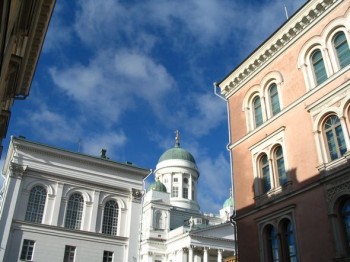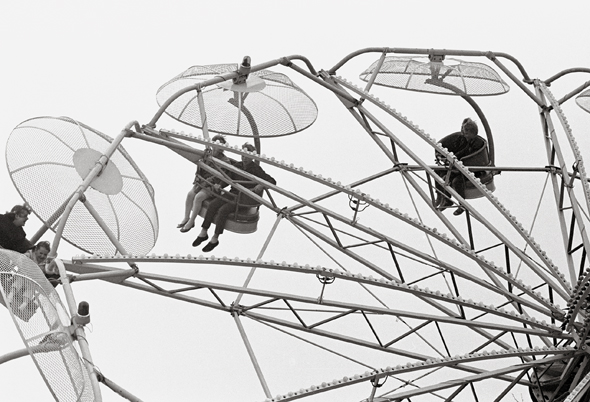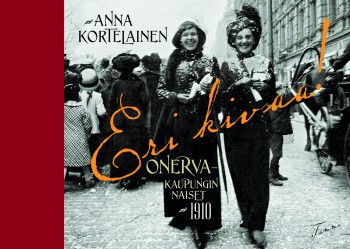Tag: Helsinki
Sun and shade
3 August 2011 | Extracts, Non-fiction

Springtime: the new graduates celebrate the beginning of summer. Photos: ©Jussi Brofeldt
Documentary film-making and photography arrived in Finland in the 1920s with pioneers like Heikki Aho and Björn Soldan, who founded a film company in 1925 in Helsinki. They also took thousands of photographs of their city; in a selection taken in the turbulent 1930s, people go on about their lives, rain or shine
Photographs from Aho & Soldan: Kaupunkilaiselämää – Stadsliv – City life. Näkymiä 1930-luvun Helsinkiin (‘Views of Helsinki of the 1930s’, WSOY, 2011)
Photos: Aho & Soldan@Jussi Brofeldt. Texts, by Jörn Donner and Ilkka Kippola, are published in Finnish, Swedish and English.
The exhibition ‘City life‘ is open at Virka Gallery of the Helsinki City Hall from 1 June to 4 September.
Aho and Soldan were half-brothers, Heikki the eldest son of the writer Juhani Aho (1861–1921; an extract from one of his novels is available here) and the artist Venny Soldan-Brofeldt. (Juhani Aho changed his original Swedish surname, Brofeldt, to Aho in 1907), Björn Soldan was Aho’s son from an extramarital relationship. More…
Best in show
30 June 2011 | This 'n' that

Cooler than we thought: Helsinki. Photo: Leena Lahti
So Helsinki has just come out top in Monocle magazine’s Quality of Life survey.
Monocle, which takes a determinedly internationalist and unfailingly style-conscious view of politics, business, culture and design, was founded by its editor Tyler Brûlé in 2007. As anyone who follows his weekly column in the Financial Times will know, Brûlé leads a peripatetic life that will have given him personal experience of most, if not all, of the 25 cities under Monocle’s lens in this survey.
Monocle’s preferences, as the top three cities on the list indicate – Helsinki is followed by Zurich and Copenhagen – is for small, well organised, forward-looking cities. Oh, and ones with good water pressure – his home town of London, which might otherwise have featured higher on the list, was debarred by its Victorian water system, which rules out the cheering experience of an energising shower before work in the morning.
So, on a list clearly based on the minutest of scrutiny, just what is it that makes life in Helsinki so different, so appealing?
According to the criteria used, ‘the world’s most liveable city’ boasts a low crime rate, good school system, excellent public transport and low unemployment – but where Helsinki really stands out, for Monocle, is in its continuous implementation of intelligent urban planning (large docklands in the city centre have been demolished, for example, and replaced by desirable new housing areas) and its dynamic, can-do, approach to doing business.
Oh, and the eating and food culture in the city is flourishing, as the ‘New Nordic Cuisine’ rules. And, Monocle being Monocle, the sheer physical beauty of the city will have played its part in earning it its accolade. More details are to be found in the current, July-August, issue of Monocle.
Much of this is certainly true. From a resident’s point of view, Helsinki’s street culture has been transformed in the past fifteen to twenty years. The transportation system is a delight, although one that Helsinki people tend to take for granted, with clean buses, trains and trams running, broadly speaking, on time, as is the education system, with the state providing excellent schools to the extent that private-sector education is practically non-existent.
As for what the ‘New Nordic Cuisine’ is exactly, this remains slightly elusive to your editors here at Books from Finland, although it clearly has to do with well-sourced, locally grown food and simple flavours. We do agree that the demise of the less-hip beer-drinking dens of yesteryear and the rise of well-lit cafés and restaurant with pleasant outdoor seating are indeed reality. Old greasy spoons are on the wane, definitely.
Oh yes: and there’s nothing wrong with Helsinki’s water pressure. Our morning showers are decidedly brisk and invigorating.
Kvinnornas Helsingfors: en kulturhistorisk guide [Women’s Helsinki: a culture-historical guidebook]
6 May 2011 | Mini reviews, Reviews
 Kvinnornas Helsingfors: en kulturhistorisk guide
Kvinnornas Helsingfors: en kulturhistorisk guide
[Women’s Helsinki: a cultural-historical guidebook]
Red. [Ed. by] Anna Biström, Rita Paqvalén, Hedvig Rask
Helsingfors: Schildts, 2010. 251 p., ill.
ISBN 978-951-50-2007-9
Finnish-language edition: Naisten Helsinki: kulttuurihistoriallinen opas
ISBN 978-951-50-1994-3
€ 34, paperback
A group comprising fourteen women has addressed the question of what the map of Helsinki would look like seen through women’s history: what are the most significant places and monuments; what traces of women’s history could one read in the fabric of the city? This book portrays various eras in the city’s history from the 16th century onwards, along with profiles of female pioneers in fields from architecture to parliamentarians, from early political activists to present-day squatters. Helsinki has often been called ‘the city of women’ due to the large influx of women who came to work in the Finnish capital, particularly in the early 20th century – the increase in the number of office girls even boosted the publishing and film industries. In his Finnish letters written in the 1890s, Spanish author and diplomat Ángel Ganivet expressed his horror at the bicycling women of Helsinki. This book also includes pieces written by prominent contemporary women, from Finnish President Tarja Halonen to author Pirkko Saisio.
Translated by Ruth Urbom
Bright lights, small city
26 August 2010 | Articles, Non-fiction

Helsinki people on the big wheel: Linnanmäki amusement park, 1968

Helsinki people on the big wheel: Linnanmäki amusement park, 1968
Photographs and excerpts from Helsinki 1968 by Claire Aho and Kjell Westö (text in Finnish, Swedish and English; WSOY, 2010)
A year that rocked the world: 1968. The Vietnam War, the Chinese cultural revolution, the invasion of Czechoslovakia, hunger in Biafra. Helsinki that year: a quiet little city, in a quiet little country. But Finland’s baby-boomers, born after the war, were now coming of age, resulting in the beginnings of a change of generation in politics; and the students of Helsinki University joined the global student unrest of this ‘crazy year’. Photographer Claire Aho takes a series of photographs of her home town, participating in an exhibition in Kiel, Germany. Forty-two years later her photos are published in Helsinki 1968, together with reflections by Kjell Westö, whose novels are deeply rooted in his native city. Here are words and images of Helsinki that mirror the past – and the present
Both the city and its people carry their past with them, find it hard to let go, and don’t really want to. Many of us are reluctant to embrace the new. Hence there is often something ambivalent, something enigmatic in the frozen moment of the photograph…. More…
Women and the city
17 April 2010 | This 'n' that
How was city life for the single woman a hundred years ago in Helsinki?
She could ride a bike, for example, provided it was equipped with an ‘alarm system’ and the speed was not high. Socially she could have fun as long as she obeyed the rules. No admittance to restaurants without male company, for example.
Some young women in those days had to make a living by teaching or by working in an office – before they got married, of course.
A new exhibition (25 March–29 August) at Helsinki’s Ateneum art museum, entitled Kaupungin naiset (‘Women of the city’), focuses on the cultural life of young women in Helsinki in the 1910s through the eyes of the writer and critic L. Onerva (aka Hilja Onerva Lehtinen, 1882–1972). More…
The winter’s tale
15 March 2010 | This 'n' that
 It’s coming to an end now, but Helsinki has been experiencing its snowiest winter since the 1970s. Since Christmas the mercury has generally stayed ten to twenty degrees below zero.
It’s coming to an end now, but Helsinki has been experiencing its snowiest winter since the 1970s. Since Christmas the mercury has generally stayed ten to twenty degrees below zero.
People have long been complaining about the black ‘Euro winters’ – the arrival of really mild winter weather as a norm seemed to coincide with Finland’s membership of the European Union in 1995 – but now the boot’s on the other foot.
Speaking of which: young city people have gone on wearing their Converses, partly because they’ve never had to invest in proper winter footwear, partly to be cool. And it certainly has been.
Spring is almost here, but right now the forecast says there’s still time to ski. So, here are some suggestions we found on a maverick site called We Love Helsinki; open to everyone, this communal webzine (in Finnish only) features all sorts of material, from places to people, happenings, photos and observations, including a wryly ironic series on Helsinki’s most romantic places. Here are We Love Helsinki’s top tips for enjoying winter (translation below) in the city for those who haven’t really been through it before; they may also come in useful for any of our dear readers whose home cities are also experiencing unusually cold weather this year:
Snowsnow blahblahblah
The winter’s been going on for too long and it’s been gawped at too much already. If you’ve had enough of the tobogganing slope and complaining about the weather, here are some handy hints that we at We Love Helsinki have put together for enjoying the urban winter.
1. Eat snow. Go on, e a t it.
2. Live dangerously and walk close to the walls of houses. Just don’t look up, and don’t take any notice of the protective barriers that have been put in your way.
3. Lick a rotary clothesline. [Or anything else made of metal: it’s thrillingly dangerous, as your tongue will stick. Ouch! The Editors]
4. The hours of daylight show an unpleasant tendency to increase towards spring. Minimise the effect by sleeping until six in the evening.
5. Enjoy the outdoors: take the train to work. [The Finnish rail services have been painfully ineffective this winter. The Editors]
6. Or save time and skate to work.
7. Ski. Just ski.
8. See if you can die of irritation by digging the wrong car out of the snow.
Beating the winter blues
8 January 2010 | This 'n' that
We’ve passed the solstice, so in principle the days are getting longer; but as we drag ourselves back into the office after the holidays, the mornings and evenings still seem pretty gloomy. We’re not complaining; further north, as the radio weather forecast reminds us daily, it’s even darker. Here, sunrise is after nine and sunset before four; further north, in Utsjoki, right up in the Arctic, it set in late November and won’t rise again until 16 January.
Still, even here, any glimmer of light is welcome. All over the city, at this time of year, SADS cafes spring up, with high-intensity light sources to combat seasonal affective disorder or, as we call it in the vernacular, the winter blues. The effect, especially after a couple of hours spent in an editorial board meeting, can be electrifying. More…
Best foot forward
11 December 2009 | This 'n' that

Diem Hy and her trademark curls
When you step outside your office, what do you see? Not the streets and buildings, although photographing them could be an interesting project too, especially when you live and work in a city as self-consciously monumental as Helsinki. No; we’re talking about the shifting landscape of people and their clothes, as documented in the primarily photographic website Hel Looks.
A ‘hobby project’ by Liisa Jokinen and Sampo Karjalainen, Hel Looks documents fashion in the streets and clubs of Helsinki. It’s self-consciously a fashion project – in addition to documenting Finnish looks, Jokinen and Karjalainen want to ‘encourage people to dress and create their own styles… to promote emerging Finnish designers… because we like fashion, clothing, young people and photography.’
For us, though, the stories the pictures tell are more fascinating. Each entry shows one or two people. usually photographed in the street, accompanied by a brief quote from the subject. Some simply roll-call the designers they’re wearing, which may be interesting for the fashion pack but not so interesting for the rest of us. But others offer self-analyses that could, at the very least, furnish the beginnings of a short story. Diem Hy, 17, for example, is shown in jeans and a second-hand leather jacket: ‘My hair is my trade mark. I’m not sure if I could live without my curls’; Simo, 18, likes ‘all clothes that date from before 1992’, Buster, 18, dresses in his grandfather’s clothes and likes to think ‘that I can dress old-fashioned but keep my mind fresh.’ Tiia, 22, simply ‘likes the colour blue’ (and indeed is dressed in nothing else). The range of selves, and self-presentations, is endless. Any authors in search of a character can simply apply here.
The house the seniors built
27 November 2009 | Reviews

Yours and mine: the common dining room at Sprint
Maija Dahlström – Sirkka Minkkinen
Loppukiri. Vaihtoehtoista asumista seniori-iässä
[Sprint: alternative living for seniors]
Helsinki: WSOY, 2009. 232 p., ill.
ISBN 978-9510-4322-9
€ 32.90, paperback
‘Your elderly mother just told you she fell in the bathroom last night at 4 a.m. Now what?’ advertises the Visiting Nurse Service of New York in the New York Times. Aging people and their desire to live in their own homes is a pressing question around the world. People feel concern over their own living arrangements and those of their loved ones. Living arrangements somewhere between being in one’s own home or in a care facility are sought by many, but there are few of these options available. More…
Julia Donner & Taneli Eskola: Löytöretki Helsinkiin. Exploring Helsinki. Helsingfors på upptäcktsfärd
20 August 2009 | Mini reviews, Reviews
 Löytöretki Helsinkiin. Paikkoja, polkuja, puutarhoja. Exploring Helsinki. Places, paths, gardens. I Helsingfors på upptäcktsfärd. Platser, stigar, trädgårdar
Löytöretki Helsinkiin. Paikkoja, polkuja, puutarhoja. Exploring Helsinki. Places, paths, gardens. I Helsingfors på upptäcktsfärd. Platser, stigar, trädgårdar
Helsinki: Multikustannus, 2008. 167 p., ill.
ISBN 978-952-468-147-6
€ 42, hardback
In this book, author Julia Donner and photographer Taneli Eskola make a walking tour of the less familiar byways of their native Helsinki, in the changing seasons between 2007 and 2008. Donner quotes authors and poets while recording some of the city’s history. She takes the reader through places often ignored – small, modest enclosures between buildings that only just qualify for the name of parks, suburban parklands or the rocky spaces that have been left untouched in the heart of the city. Eskola’s photographs record the graphic details of frost and sleet as well as the first tinges of spring green, of flora, rocks, water and sky. Some of the text is printed in both Swedish and English. A map would have been useful to readers who are not familiar with Helsinki; some of the photographs also lack captions. This beautiful book, designed by Timo Numminen, is an original series of views that have not been prettified but are true to the everyday life of the city. And readers who live in Helsinki will be surprised by what they discover.
Worlds apart
18 June 2009 | Extracts, Non-fiction

Helsinki boys by the sea: in Martti Jämsä’s Polaroid lads play on the beach; in I.K. Inha’s photograph (Hietalahden satama, ‘Hietalahti harbour’), taken a century earlier, barefoot urchins meet up on the quayside
A hundred years ago the photographer I.K. Inha (1865–1930) was asked to illustrate a tourist guide to Helsinki. He took some 200 photographs, of which some 60 were included in the book, which was published by WSOY in 1910. In his new book of photographs, OPS! Helsinki Polaroid¹, Martti Jämsä (born 1959), wanders the same streets a century on, taking snapshots with his Polaroid camera. More…



